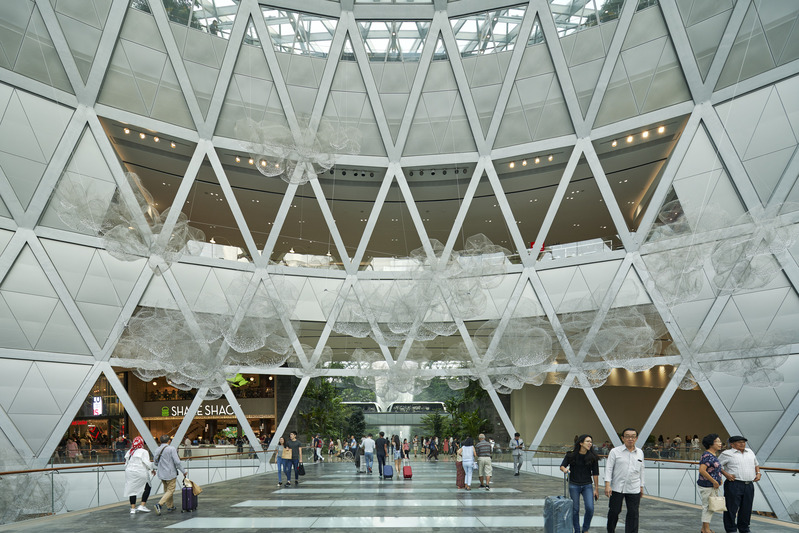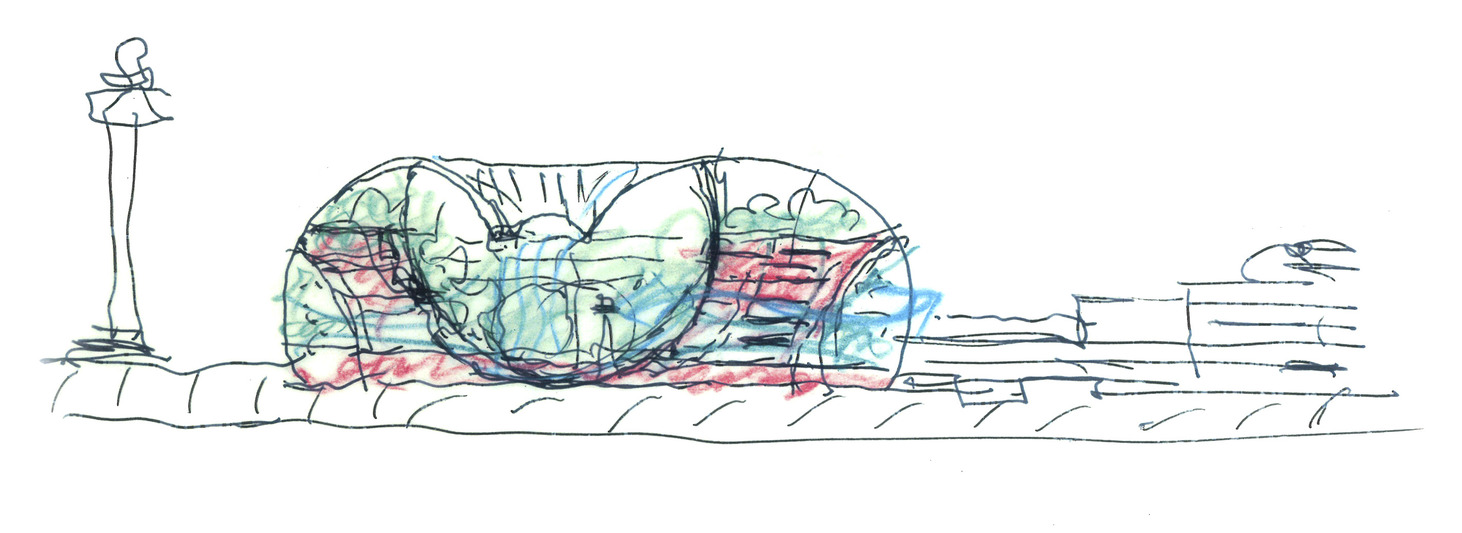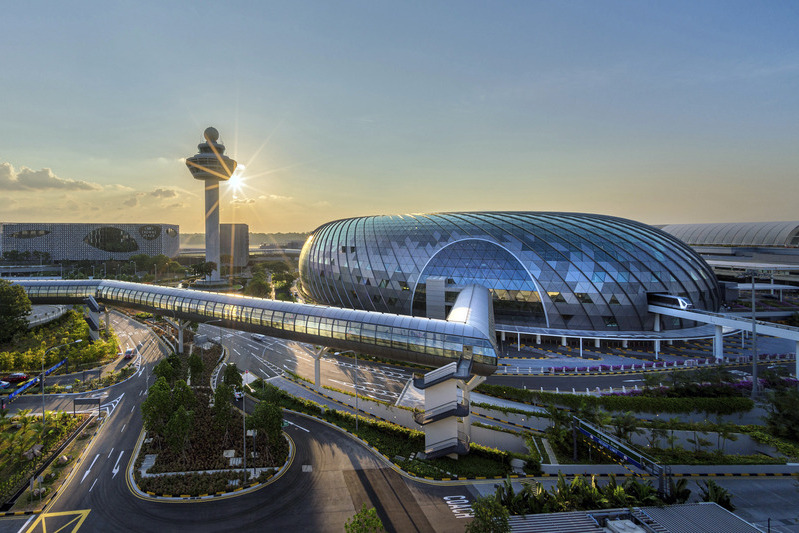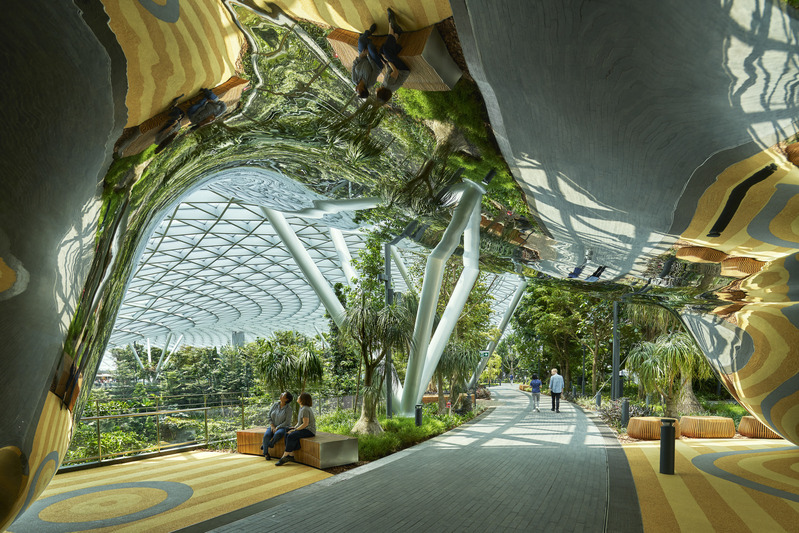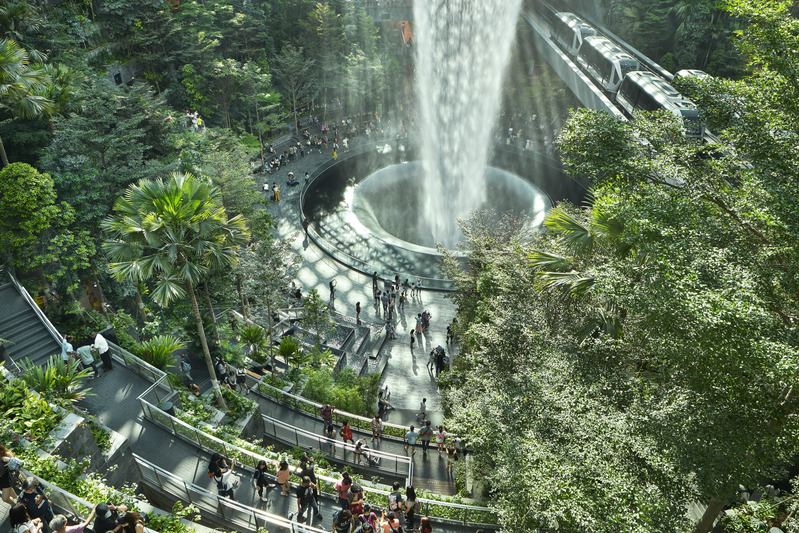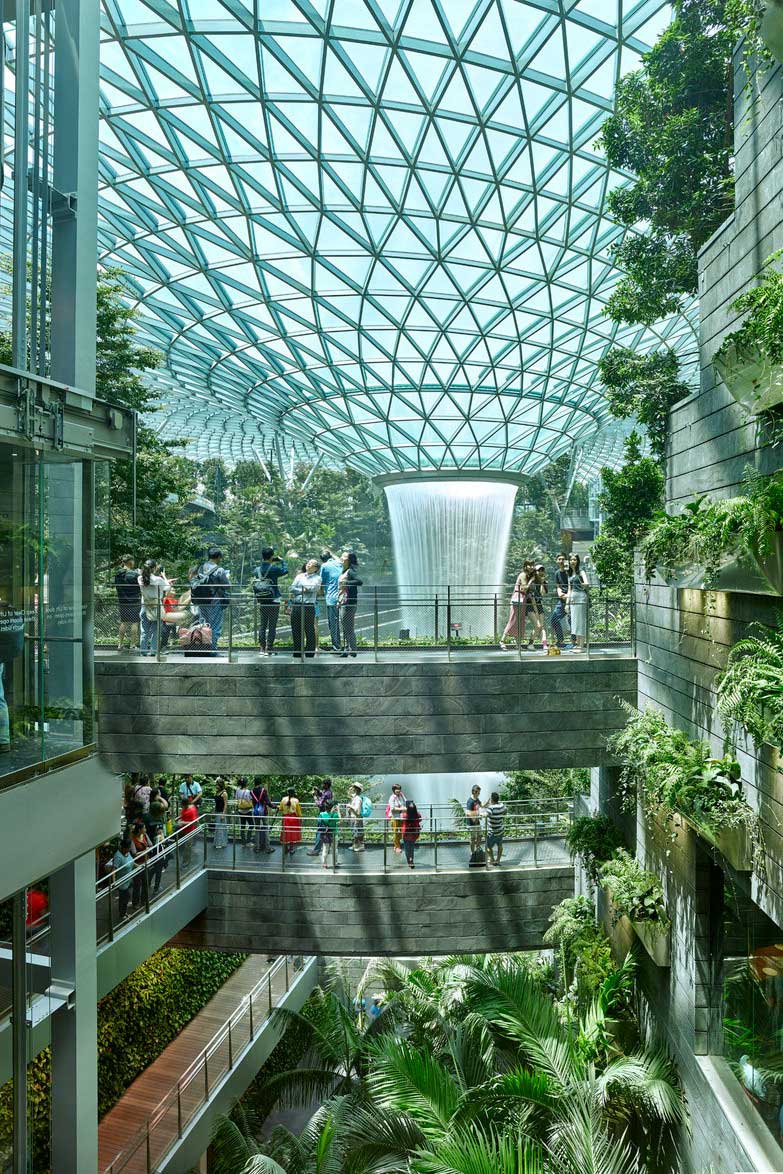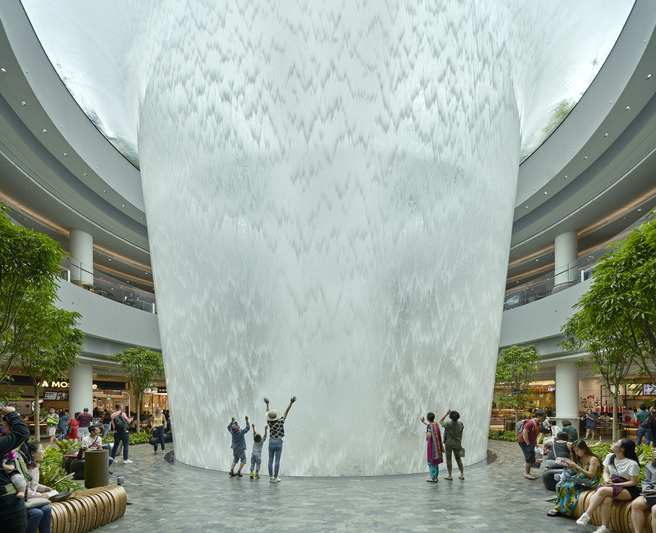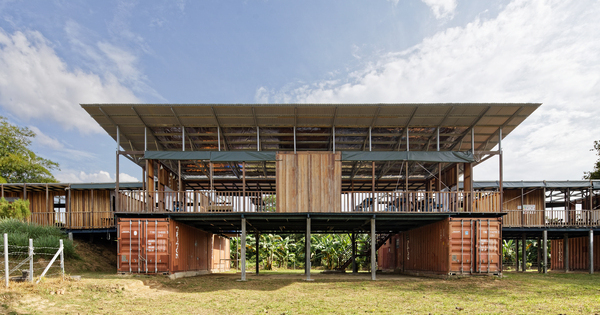DESIGN OF THE YEAR 2020
Jewel Changi Airport
Designer
Safdie Architects
In collaboration with RSP Architects Planners & Engineers (Pte) Ltd
CONTACT
[email protected]
An airport with smooth connections, decent dining options and a well-stocked souvenir store has long satisfied most air travellers. Jewel Changi Airport, however, reimagines the centre of an airport as a major public attraction to create a new community-centric heart and soul of Changi Airport.
The nature and shopping paradise bring together three of Changi Airport’s terminals with a stunning dome covered with over 9,300 glass panels. Inside, there are over 280 shops and restaurants that surround a five-storey terraced garden of over 2,000 trees and palms, and over 100,000 shrubs. At the heart of the 10-storey complex is an eye-catching oculus feature – it showers water 40 m down, creating dramatic visual effects and daily rainbows, and a cooling micro-climate effect. During the frequent and powerful thunderstorms in Singapore, the rainwater from the entire surface drains through the waterfall to be collected and reused throughout the building, and for the water feature itself.
Jewel is not just a refreshing respite for travellers but a new civic landmark. Conceived to serve the people of Singapore and travellers equally, the complex – linked to the rest of Singapore by train and bus – has become a new favourite hangout for many residents living nearby. It is truly a new crown jewel for the city-state and the world’s best airport, an iconic gateway where Singapore and the world meet.
About the Designer
Safdie Architects is led by Moshe Safdie, an architect, urban planner, educator, theorist, and author. Embracing a comprehensive and humane design philosophy, Moshe is committed to architecture that supports and enhances a project’s programme; that is informed by the geographic, social, and cultural elements that define a place; and that responds to human needs and aspirations. Over a celebrated 50-year career, he has explored the essential principles of socially responsible design with a distinct visual language.
As a Partner and Director of Safdie Architects’ Singapore office, Charu Kokate leads the firm’s efforts in Asia. She works closely with Moshe and a core team of leaders, and is a collaborative and influential point of contact for clients, contractors and consultants – from project inception to completion. Her notable experience in Singapore includes Marina Bay Sands Integrated Resort, Sky Habitat residential towers, and Jewel Changi Airport.
As Design Principal at Safdie Architects, Jaron Lubin contributes an unyielding commitment to advancing design and, consequently, the human experience. Jaron plays a critical role in the research, fellowship, and architectural exploration of the firm, and has produced an extensive portfolio of proposals, competition entries and realised projects, spanning a variety of geographic contexts, scales and programmes.
DESIGN ARCHITECT FIRM
Safdie Architects
In collaboration with RSP Architects Planners &
Engineers (Pte) Ltd
CLIENT
Changi Airport Group
CapitaLand
Jewel Changi Airport Development
RETAIL INTERIOR DESIGN
Benoy
DESIGN LANDSCAPE ARCHITECT
PWP Landscape Architecture
LANDSCAPE ARCHITECT
ICN Design International Pte Ltd
WATER FEATURE SPECIALIST
WET
LIGHTING DESIGN
Lighting Planners Associates (LPA)
DESIGN ENGINEER – ROOF AND FACADES
BuroHappold
MAIN CONTRACTOR
Woh Hup Obayashi Singapore
MEP ENGINEER
Mott MacDonald Singapore Pte Ltd
BUILDING SERVICES ENGINEERS
Atelier Ten
FIRE SAFETY ENGINEER
IGnesis
WAYFINDING AND SIGNAGE
PentagramEntro Communications
ACOUSTIC CONSULTANT
ARUP Acoustics
BUILDING MAINTENANCE
Access Advisors
QUANTITY SURVEYOR
Arcadis Singapore Pte Ltd
QUALIFIED PROFESSIONAL/EXECUTIVE DESIGN ENGINEER
RSP Architects Planners & Engineers (Pte) Ltd
DESIGN ARCHITECT FIRM
Safdie Architects
In collaboration with RSP Architects Planners &
Engineers (Pte) Ltd
CLIENT
Changi Airport Group
CapitaLand
Jewel Changi Airport Development
RETAIL INTERIOR DESIGN
Benoy
DESIGN LANDSCAPE ARCHITECT
PWP Landscape Architecture
LANDSCAPE ARCHITECT
ICN Design International Pte Ltd
WATER FEATURE SPECIALIST
WET
LIGHTING DESIGN
Lighting Planners Associates (LPA)
DESIGN ENGINEER – ROOF AND FACADES
BuroHappold
MAIN CONTRACTOR
Woh Hup Obayashi Singapore
MEP ENGINEER
Mott MacDonald Singapore Pte Ltd
BUILDING SERVICES ENGINEERS
Atelier Ten
FIRE SAFETY ENGINEER
IGnesis
WAYFINDING AND SIGNAGE
PentagramEntro Communications
ACOUSTIC CONSULTANT
ARUP Acoustics
BUILDING MAINTENANCE
Access Advisors
QUANTITY SURVEYOR
Arcadis Singapore Pte Ltd
QUALIFIED PROFESSIONAL/EXECUTIVE DESIGN ENGINEER
RSP Architects Planners & Engineers (Pte) Ltd
1NATURE MEETS SHOPPING
With its spectacular five-storey garden, 40-metre-high indoor waterfall and over 280 shops and restaurants, Jewel takes the Changi Airport experience to new heights.
(Photo by Timothy Hursley)2NATURE MEETS SHOPPING
With its spectacular five-storey garden, 40-metre-high indoor waterfall and over 280 shops and restaurants, Jewel takes the Changi Airport experience to new heights.
(Photo by Darren Soh)3GATEWAY OF CONNECTIONS
Its torus geometry helps Jewel to connect to the airport’s different terminals. At each of the cardinal axes, a gateway garden with a public artwork orientates visitors and offers visual connections to the surroundings.
(Photo by Timothy Hursley)4GATEWAY OF CONNECTIONS
Its torus geometry helps Jewel to connect to the airport’s different terminals. At each of the cardinal axes, a gateway garden with a public artwork orientates visitors and offers visual connections to the surroundings.
(Photo by Safdie Architects)5GATEWAY OF CONNECTIONS
Its torus geometry helps Jewel to connect to the airport’s different terminals. At each of the cardinal axes, a gateway garden with a public artwork orientates visitors and offers visual connections to the surroundings.
(Photo by Timothy Hursley)6A NEW GEM
Jewel replaces a former carpark in front of the airport’s Terminal 1 and is connected to Terminals 2 and 3 by a series of pedestrian bridges. Its distinctive façade is made from over 9,300 custom cut double-glazed panels – none of which is the same.
(Photo by Jino Lee, courtesy of Changi Airport Group)7CANOPY PARK
At the top of the 10-storey Jewel, of which five levels are underground, and five aboveground, is an over 14,000 sq m garden. It contains various attractions including net structures suspended within the trees, a planted hedge maze and a hanging glass-bottom bridge walk.
(Photo by Timothy Hursley)8NATURE PARADISE
The five-storey terrace garden has approximately 2,000 trees and 100,000 shrubs specially selected to thrive in Jewel’s controlled subtropical environment. Visitors can walk on two trails that cut through the “valley” and also catch glimpses of the landscape from the shopping area through the “canyons”.
(Photo by Timothy Hursley)9COOL FEATURE
The waterfall descends from Jewel’s roof all the way to its basement. During a thunderstorm, up to 10,000 gallons per minute can flow in through an oculus opening on the roof, helping to cool the environment and collect water for reuse.
(Photo by Timothy Hursley)The waterfall descends from Jewel’s roof all the way to its basement. During a thunderstorm, up to 10,000 gallons per minute can flow in through an oculus opening on the roof, helping to cool the environment and collect water for reuse.
(Photo by Timothy Hursley)11(L-R) Jaron Lubin, Charu Kokate and Moshe Safdie
(Photo by Darren Soh)12(L-R) Roderick Delgado, Peter Morgan, Charu Kokate, Tan Lee Hua, Chris Tan and Sean Chew
(Photo by Ivan Loh, pigscanfly photography)Insights from the Recipient
Safdie Architects (SA): Airports are normally places of stress and anxiety. For the passenger, their concerns are many – making a flight, possible delays, fear of flying, and the inconvenience of inspection; for the working staff, the airport is a place of relentless pressure. When Changi Airport Group decided to build a new hub, it wanted to connect its various terminals and create a facility on the landside that would be accessible to the residents of Singapore, passengers, and the airport working community. We recognised an opportunity to create something new – a compelling and enduring place, one that could become a destination in itself. Symbolically and practically, it is a place where Singapore meets the world, and the world meets Singapore.
For us, the question was: what kind of an environment would be appropriate as an airport hub? We believed it should be a place of calmness and repose, uplifting, full of light, and a place where one connects with nature. All these might sound like the antithesis of the traditional airport environment. However, at some point in the evolution of the design we became convinced that the hub should be a magical garden, a place of calmness and tranquillity. We saw the opportunity of bringing together the intense marketplace, the bazaar-like traditions, wide variety in food and beverage offerings, together with mountain trails, waterfalls, flowerbeds and forests. We wanted to create a timeless place where people would want to return to, over and over again. Not just a one-time ‘wow’ experience, but a destination that becomes part of the fabric of life in Singapore. A magical garden, we believed, would be such a destination.
SA: We were initially commissioned to develop design by CapitaLand. It would be one of four submissions by developer-architect teams, each of which would come up with a general concept. The brief also requested for a major attraction, one that would become the centrepiece of the complex.
In our workshops with CapitaLand, the notion of a themed experience (dinosaurs were mentioned) similar to Disney or Universal-like attractions were proposed. Entertainment consultants were flown in from the United States, outlining the latest technologies of recent themed offerings. As the architects, we were observers; the programme was the responsibility of the developer. But we resisted being passive observers and in the dialogue that ensued, we questioned the ability for theme parks to meet the overall project objectives. The attraction, we felt, should appeal to all age groups, passengers as well as Singaporeans. It should be one that could be visited frequently, not simply a one-time experience. This essentially ruled out the theme park. Why would a passenger choose to fly through Changi Airport to see a dinosaur park? This was when the idea of a great ‘garden like no other’ emerged. At first there was scepticism, but in time it grew on everyone concerned.
SA: There is no doubt that co-locating a marketplace with a paradise garden creates a series of tensions. The retail concept incorporates large retailers and supermarkets, together with quaint food and beverage offerings. The garden – in part trails, forests and valleys – also comprises attractions such as the maze, net walks, and children’s play installation. Finding the right balance between the different amenities was one of Jewel’s major design challenges.
As we developed the concept further, the question was raised as to whether the several levels of retail should protrude and have a presence in the garden. Should the shopfronts directly look into the garden, displaying their logos and merchandise? Our position was that the two should cohabit side by side but not mix. The visual presence of retailers in the garden would compromise its serenity. When you are in the retail gallerias, however, you are made aware of the gardens through the canyons where one can catch glimpses of the landscape as well as the hovering trees above. Allowing the restaurants to peek into the garden created terraces for people to enjoy their meals among the trees and waterfall. Similarly, the attractions within the park were integrated into the design so as not to disrupt the overall garden character.
SA: Jewel has created a new paradigm – a new kind of public realm for metropolitan cities. Downtown areas have traditionally consisted of streets and piazzas, which are now often displaced by multi-level, standalone malls. Jewel offers a great lesson going forward – that the marketplace, public institutions, parks and gardens can be integrated into a singular development. It can provide not only climate control, but also fresh air, nature and a sense of openness. This coming together of what has been considered polar opposites – shopping and garden – into a singular experience is a hint of what the future holds for the public realm in a high-density city.
SA: The year of COVID-19 has distorted our senses and appreciation of possibilities. With airline travel cut down to a trickle and airports being all but abandoned, the question arises as to what is yet to come. People ask: will we continue to work from home and not commute to work? Will we carry on with meetings and conferences on Zoom without the necessity of travelling to destinations? But the pandemic has also demonstrated a hunger for collaborative work, face-to-face interactions and a need to accomplish creative work by physical contact. We believe travel will gradually recover with time as people long to travel, to interact, to partake in community events and to enjoy the face-to-face contact that were all possible before the pandemic. Jewel being a destination in itself will be even more important for Changi Airport and Singapore to draw in tourists again when that recovery happens.
Citation
Jury Citation
Nominator Citation
Martin Pedersen
Writer, Editor and Executive Director
Common Edge Collaboration
Jewel Changi Airport redefines the notion of an aviation transit hub by creating a public-centric facility accessible to transit passengers. It represents a new typology which combines retail spaces, passenger conveniences and a garden within a climate-controlled glass enclosure.
In one strategic move, the dome-shaped architecture improves the connectivity of the airport’s existing three terminals and becomes the new nexus of Singapore’s air hub. The simplicity of its structure belies the immense complexity of the task. Architecture, engineering and landscaping are beautifully integrated into a singular, iconic form with spaces that are at once welcoming, rich and lively. The mastery of design, from concept to the execution of details, makes Jewel as much a technical marvel as it is a powerful attraction. Air travellers and visitors, protected by the elegant foil-like glass dome roof, are spellbound by the dramatic water feature in the centre and its surrounding lush, tiered gardens.
The Jury applauds the architects and collaborators for creating a powerful civic landmark that places Singapore firmly on the world traveller’s map.
Jewel Changi Airport redefines the notion of an aviation transit hub by creating a public-centric facility accessible to transit passengers. It represents a new typology which combines retail spaces, passenger conveniences and a garden within a climate-controlled glass enclosure. In one strategic move, the dome-shaped architecture improves the connectivity of the airport’s existing three terminals and becomes the new nexus of Singapore’s air hub. The simplicity of its structure belies the immense complexity of the task. Architecture, engineering and landscaping are beautifully integrated into a singular, iconic form with spaces that are at once welcoming, rich and lively. The mastery of design, from concept to the execution of details, makes Jewel as much a technical marvel as it is a powerful attraction. Air travellers and visitors, protected by the elegant foil-like glass dome roof, are spellbound by the dramatic water feature in the centre and its surrounding lush, tiered gardens. The Jury applauds the architects and collaborators for creating a powerful civic landmark that places Singapore firmly on the world traveller’s map. VIEW JURORS Nominator Citation Martin Pedersen Writer, Editor and Executive Director, Common Edge Collaboration
For Singaporeans – who will have grown up in its garden, eaten at its food court, gone on dates at its movie theatre – the intense sense of wonder they’re experiencing now (and recording, copiously) at Jewel Changi Airport will be replaced by something deeper: a connection to people, places and memories, as well as a sublime relationship with nature that might be more fleeting and elusive in the future, and ultimately more important to their emotional well-being.
Whatever the future of air travel, passengers arriving years from today are unlikely to lose that initial jolt of awe upon seeing Jewel’s garden for the first time. It’s a sort of biophilic rollercoaster ride – we take in the spectacle, like children; moments later, our bodies register a kind of peace. Closing the eyes amplifies the effect. We’ve just stepped off a plane, after 12 hours sealed in that steel tube, and been handed an unexpected gift. That feeling of generosity is likely to deepen over time because Moshe Safdie and his team have used primal elements connected to our DNA: light, water (the source of life), nature, gravity and beauty. These will surely outlive the zeitgeist, at any moment in time.
And if the great garden of Changi inspires imitators – airports from all over the world, seeing dollar signs and opportunity in the creation of authentic public spaces – then that will have been just one of Jewel’s great legacies. Perhaps Changi can usher in a second golden age, one centred not so much on the miracle of flight (a given today), but on the shared humanity of everyone involved.



